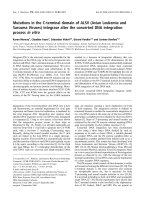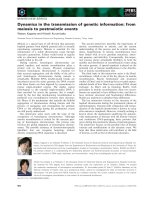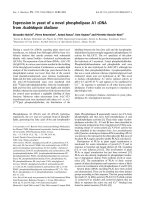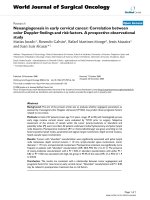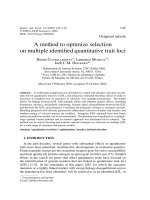Báo cáo khoa học: "Year in review 2006: Critical Care – multiple organ failure, sepsis, and shock" doc
Bạn đang xem bản rút gọn của tài liệu. Xem và tải ngay bản đầy đủ của tài liệu tại đây (71.97 KB, 7 trang )
Page 1 of 7
(page number not for citation purposes)
Available online />Abstract
In 2006, Critical Care provided important and clinically relevant
research data in the field of multiple organ failure, sepsis, and
shock. This review summarizes the results of the experimental
studies and clinical trials and discusses them in the context of the
relevant scientific and clinical background.
Introduction
Sixteen papers focusing on sepsis and multiorgan failure
were published in Critical Care in 2006. Five of them focused
on microcirculation studies in sepsis, thereby concentrating
on endothelial and leukocyte activation. Another two papers
focused on the effects of hypothermia in sepsis and surgery,
on mitochondrial and organ function during sepsis, and on
lung injury. Finally, five papers, including one presenting a
meta-analysis, were based on clinical trials.
Microcirculation, leukocyte adherence, and
endothelial activation during sepsis
Microvascular blood flow abnormalities are recognized as
one of the key features of experimental and human sepsis.
They are reported to contribute to organ dysfunction and
poorer outcome in sepsis [1,2]. In this context, intestinal
microcirculation is of great interest because the
hepatosplanchnic region is believed to assume a crucial role
for both the initiation and aggravation of sepsis [3]. Birnbaum
and colleagues [4] compared the effects of simultaneously
administering the coagulation factor XIII and endotoxin
(2.5 mg/kg per hour lipopolysaccharide [LPS] for 2 hours) to
endotoxin or saline administration alone. Intestinal functional
capillary density (FCD), leukocyte adherence in the intestinal
microcirculation, and mesenteric plasma extravasation were
evaluated in rats by means of intravital microscopy (IVM).
Both endotoxemic groups showed increased leukocyte
adherence and reduced intestinal mucosal FCD. However,
there were no changes either in the FCD of intestinal circular
and longitudinal muscle layers or in mesenteric plasma
extravasation after endotoxin. Factor XIII administration
attenuated the reduction of mucosal FCD only, whereas it
failed to affect any of the other parameters examined. In a
similar model, the same group investigated intestinal
microvascular blood flow and leukocyte adherence in rats
treated with dopexamine after the endotoxin challenge [5]. In
contrast to the previous setting, endotoxemia was performed
with 20 mg/kg LPS for a period of 15 minutes. Interestingly,
endotoxemia did not induce any changes in intestinal
mucosal FCD but decreased FCD in circular and longitudinal
muscle layers of the small intestine. Treatment with
dopexamine both attenuated the endotoxin-induced decrease
in intestinal microvascular blood flow estimated using laser
Doppler flowmetry and reduced the number of firmly adherent
leukocytes in intestinal submucosal venules. IVM also showed
an enhancement of FCD in intestinal muscle layers in the
dopexamine-treated group.
Another study of the intestinal microvasculation during
endotoxemia tried to shed light on the already recognized
beneficial effects of activated protein C (APC) in the
treatment of sepsis [6]. In animal models of sepsis, APC was
associated with improved organ function [7,8], and several
Review
Year in review 2006:
Critical Care
– multiple organ failure, sepsis,
and shock
Vladislava Simkova
1,2
, Katja Baumgart
2
, Peter Radermacher
2
, Eberhard Barth
2
and Enrico Calzia
2
1
Anesteziologicko-resuscitacni klinika, Fakultni nemocnice u sv. Anny, Pekarska 53, 656 00 Brno, Czech Republic
2
Sektion Anästhesiologische Pathophysiologie und Verfahrensentwicklung, Klinik für Anästhesiologie, Universität Ulm, Parkstrasse 11, D - 89073 Ulm,
Germany
Corresponding author: Peter Radermacher,
Published: 24 August 2007 Critical Care 2007, 11:221 (doi:10.1186/cc5938)
This article is online at />© 2007 BioMed Central Ltd
ADMA = asymmetrical dimethyl arginine; ALI = acute lung injury; AP-1 = activating protein-1; APC = activated protein C; AR = adenosine receptor;
ARDS = acute respiratory distress syndrome; BAL = bronchoalveolar lavage; COX-2 = cyklooxygenase-2; CPB = cardiopulmonary bypass; DDAH =
dimethylaminohydrolase; DHEA = dehydroepiandrosterone; DrotAA = drotrecogin alfa (activated); ERK = extracellular signal-regulated kinase; FCD =
functional capillary density; HUVEC = human umbilical vein endothelial cell; IL = interleukin; iNOS = inducible nitric oxide synthase; I/R =
ischemia/reperfusion; IVM = intravital microscopy; JNK = c-Jun amino-terminal protein kinase; LPS = lipopolysaccharide; MAPK = mitogen-
activated protein kinase; NF-κB = nuclear factor kappa B; NO = nitric oxide; NOS = nitric oxide synthase; SOFA = sequential organ failure assess-
ment; TAC = total antioxidant capacity; TNF-α = tumor necrosis factor-alpha; VEGF = vascular endothelial growth factor.
Page 2 of 7
(page number not for citation purposes)
Critical Care Vol 11 No 4 Simkova et al.
different mechanisms may be responsible for these findings.
Using IVM, Lehmann and colleagues [9] estimated FCD in
mucosal and circular and longitudinal muscle layers as well
as the leukocyte adherence in intestinal submucosal venules
after a single bolus of 15 mg/kg LPS alone or followed by
subsequent injection of human recombinant APC. Plasma
levels of inflammatory mediators tumor necrosis factor-alpha
(TNF-α), interleukin (IL)-1β, IL-6, and IL-10 were measured
also. The endotoxic animals showed both decreased FCD in
the mucosal and circular and longitudinal muscle layers of the
terminal ileum and increased leukocyte adherence in
submucosal venules. APC attenuated these effects but failed
to decrease plasma levels of inflammatory cytokines. No
differences that could be attributed to APC treatment were
observed between the two control groups, in which either
saline or APC alone was given.
A very interesting study was presented by Croner and
colleagues [10], who tried to elucidate the time course and
reciprocal influences of microperfusion, platelet adherence,
and leukocyte–endothelial interactions in the hepatic micro-
circulation during sepsis in rats. Immediately after cecal
ligation and puncture, the IVM of liver was started. Unfortu-
nately, no control group was included in this study, so the
contribution of anesthesia, missing volume resuscitation
resulting in hypovolemia, and any putative reaction to the
administration of labelled erythrocytes and thrombocytes from
donor rats could not be evaluated.
Experimental studies suggest that sex hormones assume
importance for both the post-traumatic immune response and
cardiac function [11,12]. Dehydroepiandrosterone (DHEA),
the precursor of androstendione, testosterone, and estrogen,
is synthetized in gonads and adrenal glands of both males
and females, whereas the synthesis in the adrenal gland
becomes of increasing importance in elderly men and
women. The conversion to sex hormones depends on sex-
steroid-converting enzymes in gonads and peripheral tissues
(for example, adipose tissue, muscles, skin, and lymphatic
tissue). Several animal models showed a beneficial effect of
DHEA administration in male mice after experimental trauma-
hemorrhage and/or sepsis, thereby preventing immuno-
depression and improving outcome [13,14]. Since sepsis-
related organ dysfunction is reported to be associated with
the extravasation of leukocytes, Barkhausen and colleagues
[15] investigated the expression of endothelial and neutrophil
adhesion molecules in vitro after LPS stimulation and/or
treatment with DHEA. In this study, cultures of human
umbilical vein endothelial cells (HUVECs) and neutrophils
freshly isolated from blood of male healthy volunteers were
used. Expression of the adhesion molecules VCAM-1
(vascular cell adhesion molecule-1), ICAM-1 (intercellular
adhesion molecule-1), and E-selectin on HUVECs and
expression of L-selectin, CD-11b, and CD-18 on neutrophiles
were estimated after stimulation with LPS, treatment with
both near-physiologic and pharmacological doses of DHEA
(10
–8
and 10
–5
M, respectively), or the combination of LPS
stimulation and DHEA treatment (both concentrations).
DHEA modulated the adhesion molecule expression in
endothelial cells and neutrophiles, and most effects were
detectable within the physiological concentration. However,
DHEA did not influence the adhesion molecule expression
pattern after LPS stimulus. It must be noted in this context
that humans produce DHEA in much greater quantities than
any other species. Even non-human primates present with
only 10% of the relative serum level of DHEA observed in
humans. The fact that rodents produce so little DHEA
renders such experimental results controversial. In fact, in a
porcine model of hemorrhagic shock, DHEA administration
did not have any significant beneficial effect [16]. It must be
taken into account, however, that the lacking beneficial effect
might also be ascribed to the immaturity of the animals, since
adolescent pigs were used in this experiment.
Lung injury
Acute lung injury (ALI), along with its most severe form, acute
respiratory distress syndrome (ARDS), is one of the most
challenging conditions in critical care medicine. The focus
has been the role of vascular endothelial growth factor
(VEGF), which is reported both to considerably increase
microvascular permeability and to induce proliferation and
anti-apoptotic signaling in both vascular endothelial and
alveolar epithelial cells [17-19]. These effects might assume
major importance in ALI/ARDS, promoting lung edema on the
one hand, but protecting lung epithelial cells and inducing
cell recovery on the other hand. Mura and colleagues [20]
estimated the VEGF expression in lung tissue and its
concentration in plasma and the bronchoalveolar lavage
(BAL) fluid in an extrapulmonary model of ALI induced by
intestinal ischemia/reperfusion (I/R) in rats [20]. Decreased
VEGF expression in lung tissue and diffuse increase of
interstitial cellularity, interstitial edema, and vascular
congestion together with enhanced severity of lung injury
were observed in the intestinal I/R group. These findings are
consistent with most observational studies of lung injury in
humans, showing reduction in intrapulmonary VEGF levels in
the early stages of ARDS. Whereas there were no intergroup
differences in VEGF plasma levels, protein concentration,
total cell count, and percentage of neutrophils were
increased in the BAL fluid of both intestinal I/R and sham-
operated animals, suggesting that mechanical ventilation
and/or hyperoxia may be responsible for these findings.
VEGF concentration in the BAL fluid was higher in both
ventilated groups compared to mice breathing air
spontaneously (control group), probably simply reflecting the
increased protein leakage, as the lung permeability assessed
by Evans blue dye permeability assay did not differ between
control and sham-operated groups. In the long term,
treatment modulating VEGF may be of value in ARDS, but the
challenge will be to limit the effects of such treatment to
those desired, given the pleotropic functions of VEGF in the
body [21].
Page 3 of 7
(page number not for citation purposes)
I/R-induced lung injury, which may follow situations such as
lung transplantation or cardiopulmonary bypass (CPB),
represents another challenging circumstance in intensive
care medicine. Interestingly, selective activation of A
3
adeno-
sine receptor (AR) subtype attenuated I/R-induced lung injury
and associated apoptosis [22]. ARs couple among other
types of messenger molecules to mitogen-activated protein
kinases (MAPKs), which participate in anti-inflammatory/
inflammatory cell signaling [23]. Three major MAPK families
have been identified: the extracellular signal-regulated
kinases (ERKs), the c-Jun amino-terminal protein kinases
(JNKs), and p38 kinases. Notably, whereas ERK1 and ERK2
exert a cytoprotective effect and are involved in cell
proliferation, transformation, and differentiation, p38 and JNK
promote cell injury and apoptosis [24]. Matot and colleagues
[25] evaluated MAPK activation in the reperfused lung,
comparing the effects of the highly selective A
3
AR agonist
MRS3558 with that of the moderately selective agonist IB-
MECA on lung injury and apoptosis and determined the
modulation of MAPK (ERK1, ERK2, p38, and JNK) pathways
after A
3
AR activation in a feline model of lung I/R. Both A
3
AR
agonist MRS3558 and IB-MECA attenuated alveolar injury,
lung edema, and inflammation and significantly decreased
apoptosis. The selective agonist MRS3558 allowed the same
effect with a lower dose, whereas neither MRS355M nor IB-
MECA resulted in the complete restoration observed in the
non-ischemic group. I/R increased the expression of all three
MAPKs, with significantly greater expression of JNK and p38.
Treatment with A
3
AR agonist before reperfusion markedly
increased ERK1 and ERK2 expression and attenuated
reperfusion lung injury and apoptosis, thus presenting a
promising approach for moderating lung injury and
supporting recovery after clinical I/R.
Organ (dys)function in sepsis
Organ dysfunction is a hallmark of severe sepsis, and
mitochondrial dysfunction is reported to be one of the key
mechanisms involved. Indeed, serum from patients with
septic shock significantly depressed mitochondrial respiration
in endothelial cells and decreased cellular ATP levels [26].
Furthermore, in muscle biopsies from septic patients, the
severity of shock, organ failure, and outcome were directly
related to the decreased activity of the mitochondrial complex
I, decreased ATP levels, and nitrosative and oxidative stress
[27]. Finally, despite the maintenance of tissue oxygen
availability, mitochondrial function was found to be
significantly impaired in a feline model of acute endotoxemia,
and this impairment was strongly associated with the extent
of mitochondrial ultrastructural abnormalities present in the
tissue [28]. Porta and colleagues [29] evaluated liver, kidney,
and skeletal muscle mitochondrial function in a porcine model
of prolonged resuscitated endotoxemia. Despite well-
preserved hepatic oxygen extraction and consumption and
even increased total hepatic blood flow, mitochondrial
respiratory efficiency was decreased for both hepatic
complex I and II. The mitochondrial oxygen consumption was
increased in order to maintain the membrane potential,
probably as a mirror of partial uncoupling of electron influx
and ATP production. The hepatic venous lactate/pyruvate
ratio did not change significantly until the end of the
experiment. In kidney and skeletal muscle mitochondria, no
significant changes in mitochondrial oxygen consumption and
ATP production were seen despite significantly impaired
renal blood perfusion at the end of the experiment. The
findings of this study add to the above-mentioned human data
and, in addition, suggest that the mitochondrial dysfunction
observed is not only time-dependent [30] but also organ-
specific and related to the type of shock present.
Nevertheless, they provide additional support to the concept
of mitochondria-targeted therapies [31].
Myocardial depression, as evidenced by biventricular
dilatation and reduced ejection fraction, is reported to be
present in most patients with sepsis and septic shock [32].
Although sepsis predominantly affects older persons, only
few experimental data on septic organ dysfunction in the
aged animal are available. Rozenberg and colleagues [33]
determined the degree of dysfunction of isolated and
perfused hearts from young and old rats (3 months and 24
months, respectively) subjected in vivo to experimental
endotoxemia. Strikingly, the LPS dose had to be decreased
10 times for aged rats when “mild endotoxemia” (mortality
lower than 10%) was the objective. Under basal conditions,
the hearts from senescent rats showed altered left ventricular
function, as demonstrated by reduced LVDP (left ventricular
developed pressure) and lower peaks of the positive and
negative pressure derivatives (dP/dt max and -dP/dt max).
Despite the 10-fold lower LPS dose, the relative myocardial
depression was similar in the two groups, resulting in a
further impairment of already diminished heart function of
aged rats. Interestingly, the endotoxemia-induced decrease of
myofilament Ca
2+
responsiveness was not seen in senescent
hearts. This finding could be of clinical relevance if confirmed
in vivo, as Ca
2+
sensitizing agents may thus not be as
effective in aged patients as in younger patients.
Hypothermia
Hypothermia is routinely used during cardiac surgery as it
was shown to protect organs against ischemia. Qing and
colleagues [34] tried to identify the cellular mechanisms
associated with hypothermia-mediated myocardial protection
in a porcine model of myocardial I/R injury. Standardized
CPB was performed for 2 hours either at normothermic
conditions (37°C) or during moderate hypothermia (28°C), in
which 1 hour of aortic cross-clamping was anticipated by
30 minutes of cooling of animals and consequently was
followed by 30 minutes of rewarming. Additional cooling of
hearts was performed in both groups during CPB. Myocardial
levels of TNF-α, inducible nitric oxide synthase (iNOS), and
cyklooxygenase-2 (COX-2) as well as activation of the
transcription factors c-Jun, nuclear factor kappa B (NF-κB),
activating protein-1 (AP-1), and MAPK p38 were measured
Available online />before the start of CPB, before aortic cross-clamping, before
removal of the aortic clamp, and 6 hours after CPB. Systemic
hypothermia attenuated activation of transcriptor factor c-Jun,
MAPK p38, and its downstream effector AP-1. TNF-α
expression in myocardial tissue was significantly lower in the
hypothermic group 6 hours after CPB. Myocardial COX-2
levels were significantly lower in the hypothermic animals 30
minutes after the start of CPB, but neither NF-κB activation
nor iNOS activation was prevented by hypothermia. This
study brought new insight into mechanisms involved in hypo-
thermia-associated attenuation of myocardial inflammation
and damage after an ischemic event.
In association with sepsis, both adverse and beneficial
effects of hypothermia are reported [35,36]. During hypo-
thermia, activation of platelets is induced, possibly resulting in
thromboembolic events and coagulation defects [37].
Lindenblatt and colleagues [38] evaluated the contribution of
hypothermia to activation of coagulation in endotoxic mice.
Systemic hypothermia (34°C and 31°C) further enhanced the
endotoxin-induced acceleration of microvascular thrombus
formation, in particular in arterioles, but with a significant
enhancement at 31°C only. In contrast, neither endothelial
cells nor platelets showed any additional activation due to
hypothermia. Both the plasma levels of PAI (plasminogen
activator inhibitor) and its endothelial expression were further
pronounced in hypothermic groups, thus offering a possible
explanation for a hypothermia-associated increase in pro-
thrombotic disposition.
Clinical trials
Understanding the role of apoptotic cell death in sepsis and
shock, especially its contribution to immune and organ
dysfunction, has been studied by many laboratories in recent
years. Giamarellos-Bourboulis and colleagues [39] focused
on the existence of apoptosis of blood monocytes in sepsis
and its correlation to the final outcome, as the triggering of
the cells plays a central role in the initiation of the septic
cascade. Patients with concomitant ventilator-associated
pneumonia and sepsis, severe sepsis, or septic shock were
included in the study. The apoptosis of isolated blood
monocytes was measured on days 1, 3, 5, and 7 after both
diagnoses had been simultaneously confirmed. Patients with
septic shock and blood monocyte apoptosis of less than
50% at day 1 showed higher plasma levels of pro-
inflammatory cytokines TNF-α, IL-6, and IL-8 as well as an
ultimately decreased 28-day survival. Accordingly, the
comparison between 28-day survivors and non-survivors of
septic shock showed higher blood monocyte apoptosis in
survivors at days 1 and 5. Interestingly, there was no
difference in the rate of apoptosis at days 3 and 7. The
authors suggest that apoptosis of blood monocytes could be
a beneficial mechanism during septic shock, protecting the
organism against overwhelming inflammatory response due
to a decreased release of proinflammatory cytokines. Another
aspect to consider is that a higher rate of blood monocyte
apoptosis may mirror a better balanced regulation of the
inflammatory response per se.
Oxidative stress is commonly present in inflammatory
diseases. ‘Total antioxidant capacity’ (TAC) describes the
ability of a biological sample (serum or plasma, tissue extract)
to inhibit the transformation of a selected substrate by an in
vitro-generated free radical [40]. Depending on the method
used, the plasma or serum TAC usually involves major
contributions from urate, ascorbate, and sometimes albumin
sulfhydryl groups [41]. Chuang and colleagues [42]
compared serum TAC of patients with severe sepsis with that
of healthy individuals matched to the patients with respect to
age and gender. The serum TAC level of patients with sepsis
was significantly higher than that of the healthy controls.
Furthermore, the severity of sepsis evaluated by APACHE II
(Acute Physiology and Chronic Health Evaluation II) score
was directly related to the serum TAC levels. A strong
correlation between TAC and uric acid levels in patients with
severe sepsis confirmed the contribution of urate to TAC
estimation. Bilirubin, but not albumin, contributed to serum
TAC level in this study as well. Because plasma levels of
these molecules change due to altered organ functions, other
methods should be used to evaluate oxidative stress in the
critically ill [40].
Asymmetrical dimethyl arginine (ADMA), a non-selective
inhibitor of nitric oxide synthase (NOS), is a byproduct of
protein (amino acid) metabolism. Its amount is regulated by
the scavenging enzyme dimethylaminohydrolase (DDAH), of
which two isoforms (I and II) are known. DDAH II has an
expression pattern similar to that of endothelial NOS [43]. In
cardiovascular diseases such as atherosclerosis, the amount
of endothelial dysfunction and nitric oxide (NO) bioavailability
correlated well with increased plasma levels of ADMA [44]. In
sepsis, excessive NO formation causes vasodilatation but
also assumes crucial importance in antimicrobial host
defense. Experimental inhibition of NO synthesis during
sepsis showed controversial results [45]. O’Dwyer and
colleagues [46] estimated the serum plasma level of ADMA
and IL-6 on days 1 and 7 after intensive care unit admission
in patients with severe sepsis and septic shock and evaluated
its association with vasopressor requirement. Plasma ADMA
levels correlated with both lactate levels and the sequential
organ failure assessment (SOFA) score, even if the
cardiovascular component was excluded from the total SOFA
score. On day 7, IL-6 level correlated with ADMA level also.
The patients requiring vasoactive drugs had higher levels of
ADMA, higher SOFA score, and increased mortality. At first
glance, this finding is striking since ADMA, the endogenous
inhibitor of NOS, would be expected to induce
vasoconstriction. On the other hand, one might speculate
that increased ADMA levels might reflect an adaptive
response against excessive NO production. The promoter
region of the DDAH II gene exists as C and G allelic variants.
Carriage of the G allele was associated with increased
Critical Care Vol 11 No 4 Simkova et al.
Page 4 of 7
(page number not for citation purposes)
ADMA production of both day 1 and day 7. Only 11% of
septic patients were CC homozygotes; however, further
investigation is needed to establish whether this poly-
morphism may be used as a marker for the susceptibility to
and severity of an inflammatory response secondary to an
infectious insult.
A proper function of hypothalamic-pituitary adrenal axis is
mandatory for an adequate stress response and for the
maintenance of homeostasis in stress situations. Numerous
factors, including various drugs, interfere with the hypo-
thalamic-pituitary axis [47]. Classical clinical and laboratory
findings of acute adrenal insufficiency (hypotension, hypo-
glycemia, fever, abdominal pain, or electrolyte abnormalities)
cannot be distinguished from those of sepsis. That is why
adrenal function tests are needed to identify patients with
sepsis who may profit from glucocorticoid therapy. Although
the diagnostic criteria for adrenal failure in a non-acutely ill
population are well established, there is no consensus for the
critically ill. Salgado and colleagues [48] measured baseline
total cortisol as well as cortisol levels after sequential 1 µg
and 249 µg corticotropin administration (cortisol 60 and
cortisol 120, 60 minutes after each test) and calculated
∆max
1
and ∆max
249
(cortisol 60 – baseline cortisol and
cortisol 120 – baseline cortisol) values. Clinical adrenal
failure was defined as removal of norepinephrine up to
120 hours after hydrocortisone treatment. Hydrocortisone
(100 mg intravenously three times per day) therapy was not
administered according to a predefined protocol but at the
discretion of the attending physician. Neither the baseline
cortisol value nor ∆max
1
and ∆max
249
values were able to
predict the norepinephrine removal in the general population
or in the hydrocortisone-treated group. In hypoalbuminemic
patients, significantly lower baseline cortisol and cortisol at 60
and 120 minutes were found, suggesting the potential of
overestimation of adrenal failure in the presence of
hypoalbuminemia. As no association between serum albumin
level and ∆max
1
and ∆max
249
was found, these calculations
offer an alternative to free cortisol estimation and may prevent
the false-positive diagnosis of adrenal failure influenced by
low serum albumin [49].
Drotrecogin alfa (activated) (DrotAA), also known as human
recombinant APC, was shown to improve outcome after
sepsis, but unsuccessful clinical trials of DrotAA treatment of
less severe patients and children have questioned the
unequivocal efficacy of this drug [50]. Data of patients
receiving either DrotAA or placebo enrolled in five trials of
severe sepsis with similar entry criteria and conducted by a
single sponsor were used to construct an integrated
database named INDEPTH (International Integrated Data-
base for the Evaluation of Severe Sepsis and Drotrecogin alfa
[activated] Therapy) [51]. Vincent and colleagues [52] used
this database to evaluate the effect of timing of DrotAA
treatment in severe sepsis. Kaplan-Meier 28-day survival
curves showed significantly higher 28-day survival for
patients treated with DrotAA earlier (0 to 24 hours) than for
patients treated later (more than 24 hours, 76.4% and
73.5%, respectively). Both DrotAA time-to-treatment curves
were significantly different from the placebo time-to-treatment
groups. No timing-related differences were observed in the
placebo 28-day survival curves (0 to 24 hours, 68.1%; more
than 24 hours, 67.8%). This finding does not support the
indication that solely early identification as well as treatment
of patients with severe sepsis with standard supportive care
is responsible for improved outcome after early treatment
with DrotAA [53]. However, it does suggest that early
identification and treatment of patients with severe sepsis
and consequently early treatment with DrotAA may provide
the highest benefit for these patients.
Competing interests
The authors declare that they have no competing interests.
Authors’ contributions
VS, KB, and EB contributed equally to the drafting of the
manuscript. PR and EC revised it critically for important
intellectual content. PR has given final approval of the version
to be published.
References
1. Vincent JL, De Backer D: Microvascular dysfunction as a cause
of organ dysfunction in severe sepsis. Crit Care 2005, Suppl
4:S9-12.
2. Sakr Y, Dubois MJ, De Backer D, Creteur J, Vincent JL: Persis-
tent microcirculatory alterations are associated with organ
failure and death in patients with septic shock. Crit Care Med
2004, 32:1825-1831.
3. Hassoun HT, Kone BC, Mercer DW, Moody FG, Weisbrodt NW,
Moore FA: Post-injury multiple organ failure: the role of the
gut. Shock 2001, 15:1-10.
4. Birnbaum J, Hein OV, Lührs C, Rückbeil O, Spies C, Ziemer S,
Gründling M, Usichenko T, Meissner K, Pavlovic D, et al.: Effects
of coagulation factor XIII on intestinal functional capillary
density, leukocyte adherence and mesenteric plasma extrava-
sation in experimental endotoxemia. Crit Care 2006, 10:R29.
5. Birnbaum J, Klotz E, Spies CD, Lorenz B, Stuebs P, Hein OV,
Gründling M, Pavlovic D, Usichenko T, Wendt M, et al.: Effects of
dopexamin on the intestinal microvascular blood flow and
leucocyte activation in a sepsis model in rats. Crit Care 2006,
10:R117.
6. Payen D, Sablotzki A, Barie PS, Ramsay G, Lowry S, Williams M,
Sarwat S, Northrup J, Toland P, McL Booth FV: International
integrated database for the evaluation of severe sepsis and
drotrecogin alfa (activated) therapy: analyses of efficacy and
safety data in a large surgical cohort. Surgery 2006, 140:726-
739.
7. Gupta A, Berg DT, Gerlitz B, Sharma GR, Syed S, Richardson
MA, Sandusky G, Heuer JG, Galbreath EJ, Grinnel BW: Role of
protein C in renal dysfunction after polymicrobial sepis. J Am
Soc Nephrol 2007, 18:860-867.
8. Maybauer MO, Maybauer DM, Fraser JF, Traber LD, Westphal M,
Enkhbaatar P, Cox RA, Huda R, Hawkins HK, Morita N, et al.:
Recombinant human activated protein C improves pulmonary
function in ovine acute lung injury resulting from smoke
inhalation and sepsis. Crit Care Med 2006, 34:2432-2438.
9. Lehmann C, Meissner K, Knöck A, Diedrich S, Pavlovic D,
Gründling M, Usichenko T, Wendt M, Birnbaum J: Activated
protein C improves intestinal microcirculation in experimental
endotoxaemia in the rat. Crit Care 2006, 10:R157.
10. Croner RS, Hoerer E, Kulu Y, Hackert T, Gebhard M, Herfarth C,
Klar E: Hepatic platelet and leukocyte adherence during endo-
toxemia. Crit Care 2006, 10:R15.
Available online />Page 5 of 7
(page number not for citation purposes)
11. Wichmann MW, Zellweger R, DeMaso CM, Ayala A, Chaudry IH:
Enhanced immune response in females, as opposed to
decreased responses in males following haemorrhagic shock
and resuscitation. Cytokine 1996, 8:853-863.
12. Choudhry MA, Bland KI, Chaudry IH: Gender and susceptibility
to sepsis following trauma. Endocr Metab Immune Disord Drug
Targets 2006, 6:127-135.
13. Oberbeck R, Dahlweid M, Koch R, van Griensven M, Emmendorfer
A, Tscherne H, Pape HC: Dehydroepiandrosterone decreases
mortality rate and improves cellular immune function during
polymicrobial sepsis. Crit Care Med 2001, 29:380-384.
14. Van Griensven M, Dahlweid FM, Giannoudis PV, Wittwer T,
Bottcher F, Breddin M, Pape HC: Dehydroepiandrosterone
(DHEA) modulates the activity and the expression of lympho-
cyte subpopulations induced by cecal ligation and puncture.
Shock 2002, 18:445-449.
15. Barkhausen T, Westphal B, Pütz C, Krettek C, van Griensven M:
Dehydroepiandrosterone administration modulates endothe-
lial and neutrophil adhesion molecule expression in vitro. Crit
Care 2006, 10:R109.
16. Yang R, Tibbs BM, Chang B, Nguyen C, Woodall C, Steppacher
R, Helling T, Morrison DC, Van Way CW 3rd: Effect of DHEA on
the hemodynamic response to resuscitation in a porcine
model of hemorrhagic shock. J Trauma 2006, 61:1343-1349.
17. Dvorak HF, Brown LF, Detmar M, Dvorak AM: Vascular perme-
ability factor/vascular endothelial growth factor, microvascu-
lar hyperpermeability, and angiogenesis. Am J Pathol 1995,
146:1029-1039.
18. Gerber HP, Dixit V, Ferrara N: Vascular endothelial growth
factor induces expression of the antiapoptotic proteins Bcl-2
and A1 in vascular endothelial cells. J Biol Chem 1998, 273:
13313-13316.
19. Ohwada A, Yoshioka Y, Iwabuchi K, Nagaoka I, Dambara T,
Fukuchi Y: VEGF regulates the proliferation of acid-exposed
alveolar lining epithelial cells. Thorax 2003, 58:328-332.
20. Mura M, Han B, Andrade CF, Seth R, Hwang D, Waddell TK,
Keshavjee S, Liu M: The early response of VEGF and its recep-
tors during acute lung injury: implication of VEGF in alveolar
epithelial cell survival. Crit Care 2006, 10:R130.
21. Medford ARL, Millar AB: Vascular endothelial growth factor
(VEGF) in acute lung injury (ALI) and acute respiratory dis-
tress syndrome (ARDS): paradox or paradigm? Thorax 2006,
61:621-626.
22. Rivo J, Zeira E, Galuan E, Matot I: Activation of A
3
adenosine
receptors attenuates lung injury after in vivo reperfusion.
Anesthesiology 2004, 101:1153-1159.
23. Schulte G, Fredholm BB: Signalling from adenosine receptors to
mitogen activated protein kinases. Cell Signal 2003, 15:813-817.
24. Xia Z, Dickens M, Raingeaud J, Davis RJ, Greenberg ME: Oppos-
ing effects of ERK and JNK-p38 MAP kinases on apoptosis.
Science 1995, 270:1326-1331.
25. Matot I, Weiniger CW, Zeira E, Galun E, Joshi BV, Jacobson KA:
A
3
adenosine receptors and mitogen-activated protein
kinases in lung injury following in vivo reperfusion. Crit Care
2006, 10:R65.
26. Boulos M, Astiz ME, Barua RS, Osman M: Impaired mitochondr-
ial function induced by serum from septic shock patients is
attenuated by inhibition of nitric oxide synthase and
poly(ADP-ribose) synthase. Crit Care Med 2003, 31:353-358.
27. Brealey D, Brand M, Hargreaves I, Heales S, Land J, Smolenski R,
Davies NA, Cooper CE, Singer M: Association between mito-
chondrial dysfunction and severity and outcome of septic
shock. Lancet 2002, 360:219-223.
28. Crouser ED, Julian MW, Blaho DV, Pfeiffer DR: Endotoxin-
induced mitochondrial damage correlates with impaired res-
piratory activity. Crit Care Med 2002, 30:276-284.
29. Porta F, Takala J, Weikert C, Bracht H, Kolarova A, Lauterburg
BH, Borotto E, Jakob SM: Effects of prolonged endotoxemia on
liver, skeletal muscle and kidney mitochondrial function. Crit
Care 2006, 10:R118.
30. Brealey D, Karyampudi S, Jacques TS, Novelli M, Stidwill R, Taylor
V, Smolenski RT, Singer M: Mitochondrial dysfunction in a long-
term rodent model of sepsis and organ failure. Am J Physiol
Regul Integr Comp Physiol 2004, 286:R491-497.
31. Protti A, Singer M: Bench-to-bedside review: potential strate-
gies to protect or reverse mitochondrial dysfunction in
sepsis-induced organ failure. Crit Care 2006, 10:228.
32. Krishnagopalan S, Kumar A, Parrilo JE, Kumar A: Myocardial dys-
function in the patient with sepsis. Curr Opin Crit Care 2002,
8:376-388.
33. Rozenberg S, Besse S, Brisson H, Jozefowicz E, Kandoussi A,
Mebazaa A, Riou B, Vallet B, Tavernier B: Endotoxin-induced
myocardial dysfunction in senescent rats. Crit Care 2006, 10:
R124.
34. Qing M, Wöltje M, Schumacher K, Sokalska M, Vazquez-Jimenez
JF, Minkenberg R, Seghaye MC: The use of moderate hypother-
mia during cardiac surgery is associated with repression of
tumour necrosis factory-
αα
via inhibition of activating protein-
1: an experimental study. Crit Care 2006, 10:R57.
35. Marik PE, Zaloga GP: Hypothermia and cytokines in septic
shock. Norasept II Study Investigators. North American study
of the safety and efficacy of murine monoclonal antibody to
tumor necrosis factor for the treatment of septic shock. Inten-
sive Care Med 2000, 26:716-721.
36. Scumpia PO, Sarcia PJ, Kelly KM, DeMarco VG, Skimming JW:
Hypothermia induces anti-inflammatory cytokines and inhibits
nitric oxide and myeloperoxidase-mediated damage in the
hearts of endotoxemic rats. Chest 2004, 125:1483-1491.
37. Straub A, Breuer M, Wendel HP, Peter K, Dietz K, Ziemer G: Crit-
ical temperature ranges of hypothermia-induced platelet acti-
vation: possible implications for cooling patients in cardiac
surgery. Thromb Haemost 2007, 97:608-616.
38. Lindenblatt N, Menger MD, Klar E, Vollmar B: Systemic
hypothermia incerases PAI-1 expression and accelerates
microvascular thrombus formation in endotoxemic mice. Crit
Care 2006, 10:R148.
39. Giamarellos-Bourboulis EJ, Routsi C, Plachouras D, Markaki V,
Raftogiannis M, Zervakis D, Koussoulas V, Orfanos S, Kotanidou
A, Armaganidis A, et al.: Early apoptosis of blood monocytes in
the septic host: is it a mechanism of protection in the event of
septic shock? Crit Care 2006, 10:R76.
40. Lemineur T, Deby-Dupont G, Preiser J-Ch: Biomarkers of oxida-
tive stress in critically ill patients: what should be measured,
when and how? Curr Opin Clin Nutr Metab Care 2006, 9:704-
710.
41. Halliwell B, Whiteman M: Measuring reactive species and
oxidative damage in vivo and in cell culture: how should you
do it and what do the results mean? Br J Pharmacol 2004,
142:231-255.
42. Chuang C, Shiesh S, Chi C, Tu Y, Hor L, Shieh C, Chen M:
Serum total antioxidant capacity reflects severity of illness in
patients with severe sepsis. Crit Care 2006, 10:R36.
43. Leiper JM, Santa Maria J, Chubb A, MacAllister RJ, Charles IG,
Whitley GS, Vallance P: Identification of two human dimethy-
larginin dimethylaminohydrolases with distinct tissue distrib-
utions and homology with microbial arginin deiminases.
Biochem J 1999, 106:987-992.
44. Stuhlinger M: Asymmetric dimethyl arginine (ADMA): a novel
cardiovascular risk factor? Wien Med Wochenschr 2007, 157:
57-60.
45. Hauser B, Bracht H, Matejovic M, Radermacher P, Venkatesh B:
Nitric oxide synthase inhibition in sepsis? Lessons learned
from large-animal studies. Anesth Analg 2005, 101:488-498.
46. O’Dwyer MJ, Dempsey F, Crowley V, Kelleher DP, McManus R,
Ryan T: Septic shock is correlated with asymmetrical dimethyl
arginine levels, which may be influenced by a polymorphism
in the dimethylarginine dimethylaminohydrolase II gene: a
prospective observational study. Crit Care 2006, 10:R139.
47. Prigent H, Maxime V, Annane D: Clinical review: corticotherapy
in sepsis. Crit Care 2004, 8:122-129.
48. Salgado DR, Verdeal JCR, Rocco JR: Adrenal function testing in
patients with septic shock. Crit Care 2006, 10:R149.
49. Arafah BM: Hypothalamic pituitary adrenal function during crit-
ical illness: limitation of current assessment methods. J Clin
Endocrinol Metab 2006, 91:3725-3745.
50. Eichacker PQ, Natanson C: Increasing evidence that the risks
of rhAPC may outweigh its benefits. Intensive Care Med 2007,
33:396-399.
51. Abraham E, Williams MD, Nelson DR, Laterre P, Bernard GR,
Vincent JL: Baseline characteristics and placebo mortality of
severe sepsis patients in the INDEPTH integrated database
[abstract]. Crit Care Med 2003, 31:A123.
52. Vincent JL, O’Brien J Jr., Wheeler A, Wittebole X, Garg R, Trza-
skoma BL, Sundin DP: Use of integrated clinical trial database
Critical Care Vol 11 No 4 Simkova et al.
Page 6 of 7
(page number not for citation purposes)
to evaluate the effect of timing of drotrecogin alfa (activated)
treatment in severe sepsis. Crit Care 2006, 10:R74.
53. Nguyen HB, Corbett SW, Steele R, Banta J, Clark RT, Hayes SR,
Edwards J, Cho TW, Wittlake WA: Implementation of a bundle
of quality indicators for the early management of severe
sepsis and septic shock is associated with decreased mortal-
ity. Crit Care Med 2007, 35:1105-1112.
Available online />Page 7 of 7
(page number not for citation purposes)

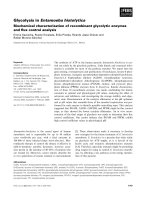
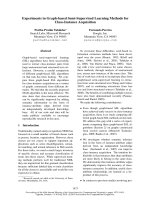
![Báo cáo khoa học: Investigation of the interaction between the atypical agonist c[YpwFG] and MOR docx](https://media.store123doc.com/images/document/14/rc/ht/medium_57MlXT7HZ5.jpg)
